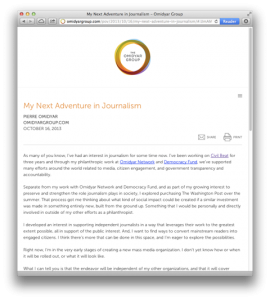So Nice To See People With Money Regard Journalism As Not Doomed
 The journalism business is screwed. The newspaper death watch continues as the layoffs grind on; the papers “lucky” enough to be bought out by the wealthy may find that their new overlords are ax-grinding control freaks, if not at a Sam Zell level of maliciousness.
The journalism business is screwed. The newspaper death watch continues as the layoffs grind on; the papers “lucky” enough to be bought out by the wealthy may find that their new overlords are ax-grinding control freaks, if not at a Sam Zell level of maliciousness.
Except that the content business is awesome, fueled by multi-million-dollar funding rounds for startups aimed at the old-fashioned business model of stringing together words and pictures in a pleasing and informative sequence.
Both sentences can be true and yet not tell the full story. Consider the newest development in journalism, eBay founder Pierre Omidyar’s decision to bankroll a new, full-spectrum news site with investigative journalist Glenn Greenwald, documentary filmmaker Laura Poitras and Nation writer Jeremy Scahill.
This still only vaguely defined venture–see NYU journalism professor and Omidyar advisor Jay Rosen’s explainer–is like other recent news startups in having a pixels-only orientation. Paper won’t be part of its equation, so it won’t have the added cost of printing and distribution or the risk of mission conflict between print and online.
It also won’t start out with such other legacy issues of established papers as print-first content-management systems or a hesitancy to engage on social media or link out to competing news sites.
And Greenwald, Poitras, Scahill and their future colleagues will start out with money behind them. Some $250 million of it, the amount Omidyar was ready to pay when he considered buying the Washington Post.
That makes the funding rounds some newer sites have racked up–$46.3 million for BuzzFeed, $18.6 million for Business Insider–look paltry. (I haven’t been able to give too much credence to gaudy Series A rounds, not since the the vapid photo-sharing app Color scored $41 million in VC funding before shipping anything.)
But two key things set Omidyar’s project apart from other post-print news startups.
One is that Omidyar is not actually new to this.
As the Washington Post’s Paul Farhi notes in a feature today, he earlier plowed millions into two innovative ventures into tech-augmented journalism: the Sunlight Foundation, a non-profit that “uses cutting-edge technology and ideas to make government transparent and accountable,” and Honolulu Civil Beat, a local-news venture that focuses on investigative reporting.
(For more discussions on the possibilities of post-print journalism, stay tuned to the tweets coming from the Online News Association’s conference in Atlanta through this weekend. Having left last year’s ONA conference greatly encouraged about the business I have chosen, I wish I were there, but instead I’m in Santa Clara, Calif., for the Demo conference–more on that later.)
And unlike more narrowly focused new-news startups such as Upworthy (carefully curated, inspirational audio or video clips), PandoDaily (Silicon Valley tech-business dispatches) and BuzzFeed (endlessly-sharable listicles that subsidize long-form reporting), Omidyar aims for this new site to have both the mass audience and broad coverage of a traditional newspaper. As Rosen wrote:
“Omidyar believes that if independent, ferocious, investigative journalism isn’t brought to the attention of general audiences it can never have the effect that actually creates a check on power. Therefore the new entity […] will have to serve the interest of all kinds of news consumers. It cannot be a niche product. It will have to cover sports, business, entertainment, technology: everything that users demand.”
The closest parallel seems Bezos’s $250 million acquisition of my former employer. But in the Post’s case, you hope that the guy with no journalistic credentials leaves the journalists alone but shakes up the way the site presents their work and sells ads against it. With Omidyar, his experience helping Sunlight and Civil Beat argues for him spending time in the newsroom.
That makes this a big and important bet on the relevance of news, and on the reliability of a post-print business model. I hope it succeeds–but not as much as I hope much smaller news operations, without the benefit of billionaire backers or VC funding, can establish themselves and earn a decent middle-class living.







